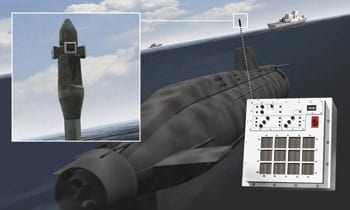
We’ve all seen the movies — Run Silent, Run Deep; Das Boot; U-571, and others — in which the submarine captain orders “up periscope,” a big tube rises, the captain quickly unfolds a pair of handles, swivels his hat backwards, and looks through eyepieces while rotating the tube around 360 degrees to see what’s on the surface.
Since the captain on the periscope is the only one who can see what’s up there, the rest of the crew waits tensely and wide-eyed for the captain to announce the presence of enemy ships.
While this makes for enjoyable movies, rest assured it’s in the ancient past and getting father in the rear-view mirror all the time. Today’s optical devices that enable submerged submarines to see what’s on the surface are far more advanced than what we see in the old movies. In fact, they’re not even called periscopes anymore.
On the U.S. Navy’s most advanced submarines today, these optical devices are called photonics masts. They have a variety of electro-optical sensors like visible-light and shortwave infrared sensors, as well as low-light cameras that feed imagery through strands of optical fiber and onto high-resolution displays in the submarine’s control room.
The mast’s operator points the sensors and controls their fields of view with a joystick or even an off-the-shelf video game controller. No one stands at a periscope anymore, which offers advantages in situational awareness, maintenance, reliability, and even in the design of the submarine itself.
Traditional periscopes of the past forced submarine designers to place a hole in the vessel’s pressure hull large enough for the periscope tube and its optics. Designers also had to build a periscope well in the lower portions of the boat to fit the periscope when not in use.
Aside from physical bulk, however, putting a hole in the submarine’s pressure hull caused maintenance and reliability worries. If the worst happened and something outside broke off the periscope, the damage could cause seawater to leak into the submarine.
In addition, submarine designers had to locate the submarine’s sail, control room, and periscope well in a straight line to accommodate the mechanism. With the modern photonics mast, many of those problems are gone for good.
Designers of the Navy’s Virginia-class fast-attack submarines, for example, place the vessel’s sail forward of the control room. This makes the submarine itself more hydrodynamic, and enabled designers to build a relatively large control room.
The first-generation photonics masts that went aboard the Virginia-class subs offered all these advantages, but still had a notable drawback — their large sizes, which rendered them more detectable from the surface. The photonics mast heads, moreover, were of unique size to the U.S. Navy; anyone who sees one from the surface knows it belongs to an American submarine.
That’s changing, however, with the new-design Low-Profile Photonics Mast (LPPM). This device has a slim profile about the size of a traditional submarine periscope head, making them less detectable from the surface. LPPM deployable prototypes will go aboard the Pacific Fleet’s Virginia-class submarines this year.
Read more: Not your grandfather’s submarine periscope
The Latest on: Photonics masts
[google_news title=”” keyword=”Photonics masts” num_posts=”10″ blurb_length=”0″ show_thumb=”left”]
via Google News
The Latest on: Photonics masts
- Life after logisticson December 20, 2023 at 6:59 pm
It noted at the time: The Colorado is the first attack submarine where sailors use an Xbox controller to maneuver the photonics masts, which replaced periscopes, [Colorado commanding officer Cmdr.
via Bing News









